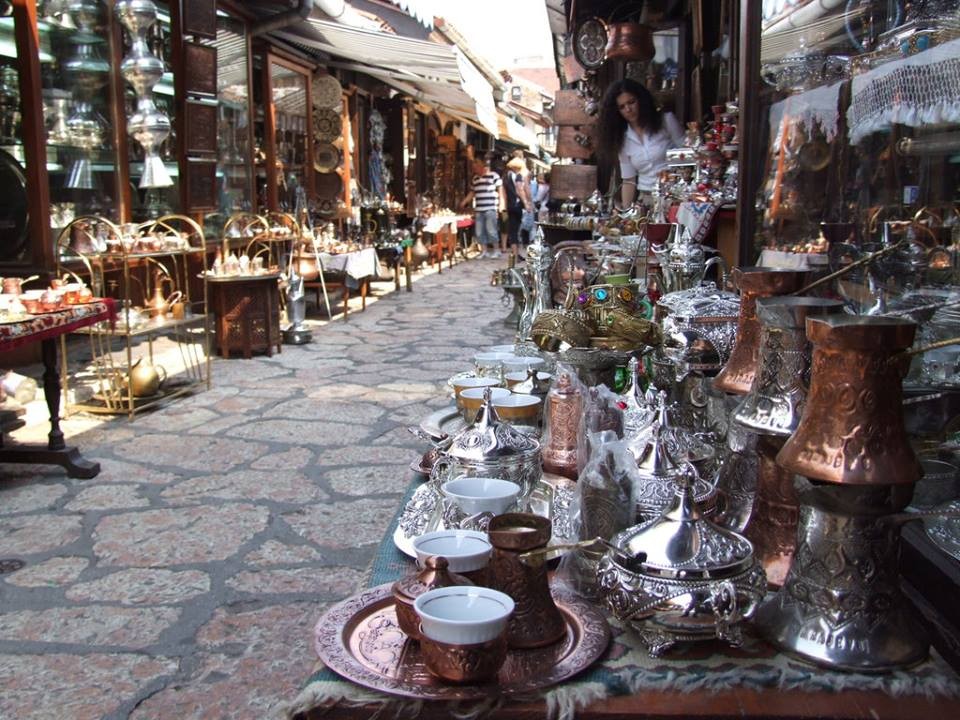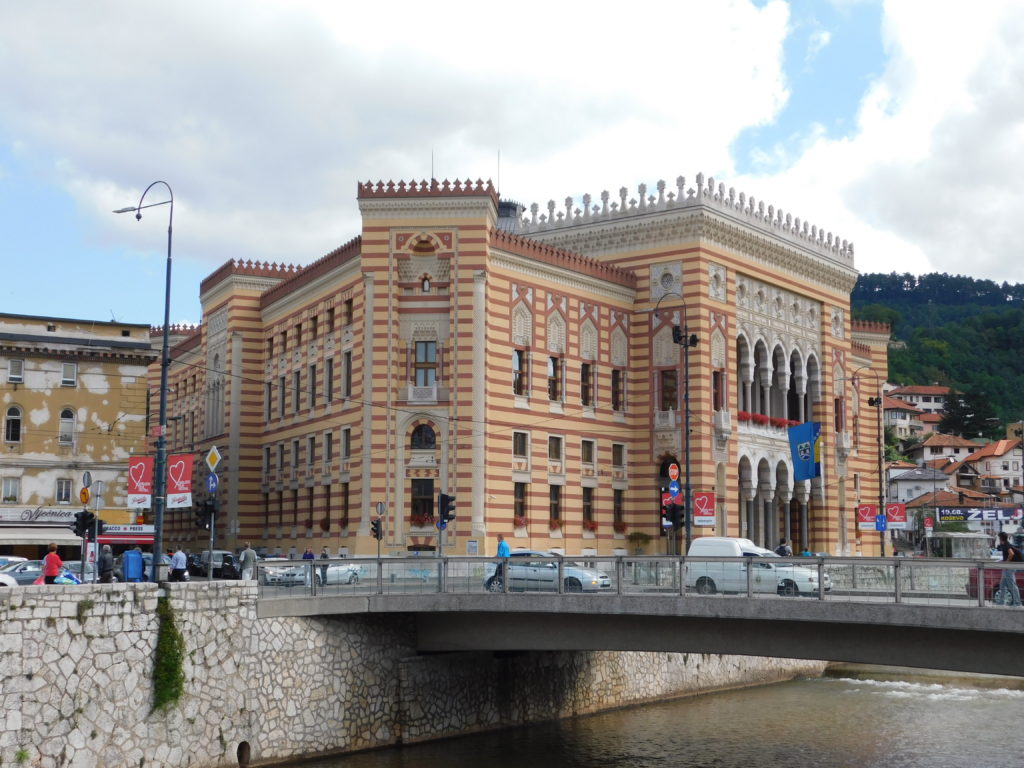A place unlike anywhere else in Europe
Life in Sarajevo but especially in the market in the 16th and 17th centuries was likely shocking, exotic, and perhaps bordering on incomprehensible to the Europeans who came to trade there. Sarajevo was ghetto free. Muslims and Jews constituted the majority of the city’s population and lived next to each other without issue. As for the market, here are a few of the reasons Eurpoeans might have been aghast:
- The sheer size of the market was unlike anything they’d seen anywhere in Europe.
- The market was open five days a week – closing on Friday and Saturday for the respective Muslim and Jewish Sabbaths.
- Although single-sex education is common across the Muslim world today, in the maktab and medresa that Gazi Husrev-Beg had built, they saw both boys and girls attending together. (Per Wikipedia, the first known co-educational school in the west was Scotland’s Dollar Academy – founded in 1802.)
- Jews, Africans, Asians, and Moors traded as freely as anyone else.
- Women and sometimes children commonly worked in the shops because their men were often away on trading trips or at war.
The various professions and crafts each had their own street or section in the baščaršija and each had a guild. Even today, the coppersmith’s street, though on a smaller scale, might provide some sense of how the market appeared in its heyday.

At this time, the guilds had the 16th century equivalent of a non-compete clause between them in the sense that a merchant in one group agreed not to sell the products or offer the services of a merchant in another – a tradition that carries on today. This extended even to the Bosnian equivalent of fast-food which is fast in the sense that it served quickly because it’s been prepared before your arrival.
Dino took us to a street that had, at one time, belonged to the locksmith’s guild but was replaced (for reasons I’ll discuss shortly) by the fast-food guild in 1751. There are three types of these fast-food eateries – aščinicas, buregdžiničas, and ćevapdžinicas – each serving a different type of food. One street in the market is lined with these “fast-food” restaurants. Aščinica translates as spoon so everything you eat here would be cooked in a pot and eaten with a spoon. Buregdžiniča means savory. So here you’ll find salty, filled dough pies filled with meat, spinach, potato, cheese, or squash. Finally, there’s cevapdžinica, which Dino called barbecue. I think a better description is rolled spiced meat balls served with thin pita-bread, onions, and yogurt. You generally won’t find alcohol or sweets in these places.
So, how did the locksmith street become the fast-food street? Over a period beginning in the early to mid-18th century, the locksmiths began breaking the unwritten rule and sold wares produced by other guilds. They found themselves shunned by not only these guilds but other businesses. They then lost representation in the city government. Without representation, the city levied higher taxes on their business and by 1751 all the locksmiths save one had left the street. One interesting point is that the shunning was enforced in part by sullying the reputation and saying that someone’s name was mud.
(Because I’m an honorary member of the royal family of digressers, I’m going to do just that. I hope American readers found the 18 century Bosnian / Turkish use of the expression equivalent to “His name is mud” as curious as I. In the States, the origin of this expression is often attributed to Dr. Dr. Samuel Mudd who treated the wounds John Wilkes Booth suffered after he assassinated Abraham Lincoln. However, if you visit the website Phrases.org.uk, you’ll find this citation: According to the Oxford English Dictionary, mud saw its first figurative uses meaning something worthless or polluting as early as the 16th century and by 1703 the OED cites a usage where mud describes a fool or a thick skulled fellow. By the early 19th century, mud was being used as an intensifier as in the expression “as sick as mud.” Thus, the “combination of meanings of ‘decaying and worthless’ and ‘extremely’ was enough for the association of it with someone’s name to become an insult – hence ‘your name is mud’.”)
Pseudo-Moorish architecture
Continuing our walking tour in reverse but stepping forward a bit in historical time, I want to return to Sarajevo’s City Hall which, in a loose way, knits together three important threads in the story of Sarajevo – the presence of pseudo-Moorish architecture, the assassination of Franz Ferdinand, and the four-year siege in the Bosnian – Serb war. For the moment, let’s look at it as an example of pseudo-Moorish architecture which served as a precursor to the Moorish Revival style that became popular in the late 19th and early 20th centuries.

But first, let’s build a general understanding of how the Austro-Hungarians came to occupy and administer the territory of B&H. Their control of the region grew out of the Congress of Berlin that was held from mid-June to mid-July 1878. In attendance were the so-called Great Powers – Russia, Great Britain, France, Austria-Hungary, Italy, Germany, and the Ottoman Empire – and the four Balkan states of Greece, Serbia, Romania, and Montenegro. One reason this meeting happened was to attempt to quell the fighting going on in and around the Balkan peninsula in the 1870s.
A partial list includes the Serbian Ottoman War that began in June 1876 when Serbia proclaimed its independence and declared war on the Ottoman Empire, the Bulgarian uprising in April and May 1876, the Montenegrin-Ottoman War that stretched from 1876 to 1878, and the Russo-Turkish War of 1877-1878. The Bulgarian and Montenegrin declarations sprung from what is known as the Herzegovina Uprising that began in 1875 and weakened the Turks by deeply engaging their military resources for much longer than they anticipated. The nominal object of the Congress was determining the territories of the states in the peninsula following the end of the Russo-Turkish War. The Treaty of Berlin was signed on 13 July 1878.
The European Great Powers all had designs and different motivations regarding the Balkans. Russia was interested in the region both ideologically as a pan-Slavist unifier and as a way of securing greater control of the Mediterranean. This Russian ambition didn’t sit particularly well with Great Britain so their interest was mainly to prevent Russia from doing exactly that. Meanwhile, Germany, which was the strongest continental power at the time, had formed an alliance with Italy that stymied Austro-Hungary’s ability to expand its domain to the southwest.
As all these political machinations pitted one power against another, reports of extensive Ottoman brutality in the in both the Herzegovina Uprising and the Serbian-Ottoman War prompted Russia, which saw itself as the protector of the Serbs, to decide to act against the Ottoman Empire. As the Russians prepared to strike the Ottomans, they sought and obtained a pledge of neutrality from Austria-Hungary. The Russians received that pledge in return for ceding undisputed control of Bosnia and Herzegovina to the Habsburgs in the Budapest Convention of 1877.
The Congress of Berlin had already given Austro-Hungary administrative control of B&H to and put the region on the fast track to full annexation. However, almost no one was happy with the provisions of the Treaty of Berlin and it ultimately proved so divisive that it utterly failed in its goal of maintaining peace and a balance of power in the region. Rather, it sowed many of the seeds that led to World War I and the conflicts that plague the peninsula to this day.
What, you’re reasonably wondering, does all this have to do with the pseudo-Moorish architecture of the Sarajevo City Hall? It’s a reasonable question. The residents of Sarajevo who were still mostly Muslims and Sephardi Jews weren’t happy with the presence of the Austrians particularly the arrogant way the Austrians tried to impose their more western social mores and architecture on the city. They boycotted as much of Austrian administration as possible by withholding taxes, refusing to send their children to Austrian schools, and so on. The Austrians then decided to try a slightly different approach to assimilating the local population.
They constructed their public buildings in a style they thought would be more aesthetically acceptable to the Sarajevans – pseudo-Moorish. Sarajevo’s City Hall was the first of these buildings. According to Dino, our city guide, throughout the country you can find more than 3,700 buildings – all with some sort of public use – in this style.
The Sarajevo building served as the City Hall until the end of World War II when it was converted into the University Library and City Archives. It was firebombed and destroyed in the nineties war but I’ll return to that later.
In the next entry I’ll examine the story of Archduke Franz Ferdinand and his assassination. It introduces a secretive organization called Black Hand and returns to Sarajevo’s City Hall, the Hotel Europe, and the Latin Bridge.